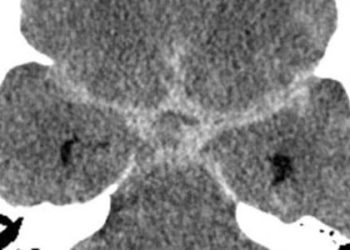Endovascular treatment of intracranial aneurysms prevents long-term recurrence
1. In patients with intracranial aneurysms who underwent complete occlusion by endovascular treatment (EVT), magnetic resonance (MR) angiography indicated that long-term recurrence was prevented in the majority of cases, but a decreased interval to follow-up may be warranted in those at risk for recurrence.
2. Increased risk of long-term recurrence include incomplete postprocedural occlusion, retreatment within 5 years, and aneurysmal fundus size greater than 10 mm at initial evaluation.
Evidence Rating Level: 1 (Excellent)
Study Rundown: Cerebral aneurysms have the potential to rupture and bleed within the brain parenchyma, causing potentially fatal consequences. A standard approach to the management of cerebral aneurysms, known as endovascular treatment (EVT), is to fill the aneurysmal region with metal coils under angiographic guidance. Once in place, the coiled wire occludes the vessel to effectively isolate the aneurysm from the circulation. The long-term therapeutic effect of EVT is not well known, and some aneurysms may recur after the procedure, necessitating endovascular or surgical retreatment. As such, the current meta-analysis and prospective study was performed to characterize the long-term efficacy of endovascular treatment and identify the risk factors associated with recurrence. MR angiography was utilized to evaluate aneurysms both before and after EVT at 3 to 5 years. The prospective arm of the study was performed in patients following EVT with bare platinum coils at a single treatment center with 10 years of follow-up physical exams and MR angiography. A systematic review and meta-analysis of the current literature was also conducted to assess aneurysm recurrence rates for 10 or more years following EVT, including the influence of aneurysm characteristics on recurrence. Prospective data showed that EVT was generally effective in preventing recurrence of bleeding, though 12.4% of patients with complete post-procedural aneurysm occlusion had angiographic evidence of recurrence at 10 years. Additional risks of recurrence were attributed to retreatment within 5 years, incomplete occlusion at initial EVT, and aneurysm size > 10 mm at initial evaluation. These findings suggest that a decreased interval to follow-up may be warranted in patients with significant risk factors for recurrence. This study was limited in that its prospective design was restricted to a single center and due to a failure to utilize digital subtraction angiography in addition to MR angiography as a gold-standard reference for aneurysm evaluation. Future studies should examine if selection of patients for early angiographic follow-up based on recurrence risk may reduce long term complications or cerebral hemorrhage rates
Click to read the study in Radiology
Relevant Reading: Endovascular treatment of intracranial unruptured aneurysms: systematic review and meta-analysis of the literature on safety and efficacy
In-Depth [meta-analysis]: This prospective study, which included 192 patients and 209 total aneurysms, was conducted using 3-T MR angiography and followed for 10 years after the EVT procedure. Of note, digital subtraction angiography was not utilized. The systematic review and meta-analysis included 2773 patients and 2902 total aneurysms drawn from articles found on PubMed, EMBASE, and Cochrane databases. Data was subsequently analyzed using univariate and multivariate analyses within subgroups. Inclusion criteria were follow-up periods of >10 years and documentation of hemorrhage and recurrence following EVT. In 12.4% of patients with complete postprocedural aneurysm occlusion (Raymond class 1), recurrence occurred between 5 and 10 years after follow-up with MR angiography. Among those with incomplete aneurysmal occlusion (Raymond class 2), the relative risk of recurrence at 3-5 years was 4.16 (99% CI 2.12 – 8.14). Additional risk factors included retreatment within 5 years (relative risk of 4.67; 99% CI, 1.55 – 14.03), incomplete initial angiographic occlusion (relative risk of 7.08; 99% CI 1.24 – 40.37), and aneurysm size > 10 mm (relative risk of 4.37; 99% CI 1.83 – 10.44). Based on systematic review data, the baseline rate of post-treatment bleeding at 10 years was 0.7% (99% CI 0.2 – 2.7) Q value = 2.7; I2 = 0%) and the de novo aneurysm rate was 4.1% (99% CI 1.7 – 9.4; Q value = 10.9; I2 = 54.1%).
Image: PD
©2015 2 Minute Medicine, Inc. All rights reserved. No works may be reproduced without expressed written consent from 2 Minute Medicine, Inc. Inquire about licensing here. No article should be construed as medical advice and is not intended as such by the authors or by 2 Minute Medicine, Inc.





